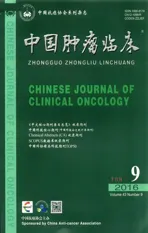抗血管生成药物对肿瘤免疫调节影响的研究进展
2016-07-14刘清菁综述蒋晓东审校
刘清菁 综述 蒋晓东 审校
抗血管生成药物对肿瘤免疫调节影响的研究进展
刘清菁综述蒋晓东审校
摘要恶性肿瘤的治疗已进入“精准治疗”时代,抗肿瘤血管生成的靶向治疗是近年非常热门的研究方向,而肿瘤免疫逃逸是导致肿瘤治疗效果不理想的重要原因之一。抗血管生成治疗不仅能够抑制血管生成,使肿瘤退缩,并且能够减少肿瘤微环境中免疫抑制性细胞数量,提高肿瘤浸润淋巴细胞(tumor-infiltrating lymphocyte,TIL)、细胞毒性淋巴细胞(cytotoxic lymphocyte,CTL)等的数量,从而克服肿瘤免疫逃逸。本研究对抗血管生成药物通过改善肿瘤微环境,增强机体抗肿瘤免疫功能进行综述。
关键词抗血管生成肿瘤免疫逃逸肿瘤微环境
作者单位:徐州医科大学附属连云港医院肿瘤放疗科(江苏省连云港市222002)
肿瘤血管生成在实体肿瘤的生长、侵袭和转移过程中发挥重要作用。Folkman于1971年提出“血管生成过程可作为抑制实体肿瘤生长的靶点”的假说,从而开创了抗肿瘤血管生成研究的新纪元。肿瘤血管的杂乱无章主要是由于肿瘤组织中促血管生成因子和抗血管生成因子的失衡。在肿瘤促血管生成因子中,血管内皮生长因子(vascular endothelial growth factor,VEGF)及其受体,即血管内皮生长因子受体(vascular endothelial growth factor receptor,VEGFR)被认为是最具潜力的抗血管生成治疗靶点,针对VEGF通路的抗血管生成靶向药物越来越多地用于临床治疗和研究:肾透明细胞癌移植瘤小鼠模型中,舒尼替尼(sunitinib)和阿柏西普均能明显抑制肿瘤生长[1];结直肠癌肝转移患者的临床试验中,新辅助化疗联合贝伐单抗在客观疗效和疾病控制方面均有成效,尤其能提高完全病理缓解率[2];转移性胃癌患者临床试验中,阿帕替尼相较于安慰剂对照组可明显提高总生存率和无进展生存期[3];在晚期胃癌或胃食管交界部腺癌患者临床试验中,紫杉醇联合雷莫卢单抗较联合安慰剂可显著提高总生存率[4]。此外,还有多靶点抗血管生成药物,如血管内皮抑素(恩度,rhendostatin,又称重组人内皮抑素),其联合化疗治疗进展期非小细胞肺癌患者时总缓解率和疾病控制率均显著提高[5]。抗血管生成的作用机制复杂多样,其中有研究认为抗血管生成治疗在阻止肿瘤血管生成的同时还具有调节机体免疫功能的作用。
近年肿瘤持续血管生成和免疫逃逸均被纳入肿瘤十大特征之中[6]。肿瘤细胞可分泌大量免疫抑制因子,如转化生长因子-β(transforming growth factorbeta,TGF-β)、VEGF、白介素-10(interleukin-10,IL-10)、白介素-6(interleukin-6,IL-6)、前列腺素E2 (prostaglandin E2,PGE2)、巨噬细胞集落刺激因子(macrophage colony-stimulating factor,M-CSF)等,抑制免疫细胞如树突状细胞(dendritic cells,DC)、细胞毒性淋巴细胞(cytotoxic lymphocyte,CTL)、天然杀伤细胞(natural killer cell,NK细胞)的功能[7-8],并募集大量免疫抑制性细胞至肿瘤组织中,如肿瘤相关巨噬细胞(tumor-associated macrophages,TAM)、调节性T细胞(regulatory T cell,Treg)、髓源性抑制细胞(my⁃eloid-derived suppressor cells,MDSC)等,这些免疫抑制性细胞可分泌免疫抑制性因子,进而构建成一个正反馈的免疫抑制性网络[9],最终这些分子与细胞共同组成功能复杂的肿瘤免疫抑制性微环境,使肿瘤灶成为抗原特异性T细胞不能发挥作用的“免疫赦免区”。
肿瘤微环境中细胞、分子和细胞因子之间互相影响且机制复杂。其中VEGF作用尤为特殊,其不仅在肿瘤血管生成中扮演了重要角色,而且在肿瘤免疫逃逸的多个环节中发挥重要作用,如DC的成熟[10],诱导成熟DC表达PD-L1,从而影响T细胞活化[11],并且影响CTL的产生[10,12]。
1 抗血管生成药物对T淋巴细胞特异性识别抗原的影响
抗肿瘤免疫识别主要依赖于抗原递呈细胞(anti⁃gen presenting cell,APC)识别肿瘤抗原,而DC是功能最强大的抗原递呈细胞,被认为是启动机体免疫反应的始动者。抗血管生成主要影响DC成熟和功能。Jin等[13]证实低分化食管鳞癌细胞上清可通过STAT3诱导不成熟DC内皮化从而失去抗原递呈功能,而Pardoll等[11]则证实VEGF可通过诱导成熟DC表达PD-L1,影响DC递呈抗原的功能。动物实验和临床试验均提示抗VEGF治疗可提高成熟DC数目及功能[14],在荷瘤鼠模型和临床试验中阻断VEGF或VEGFR2后均可恢复DC的功能[15]。
2 抗血管生成药物对T细胞活化、增殖和分化的影响
T细胞在发挥免疫杀伤作用之前必须经历由活化引起的细胞分裂,并大量增殖,达到整体功能所需的数量水平;还经历由活化引起的细胞分化,使其具有分泌细胞因子或细胞杀伤的功能,而抗血管生成在此环节通过影响肿瘤微环境中抑制性细胞和细胞因子调节T细胞的活化。
2.1 抗血管生成药物对肿瘤微环境中免疫抑制性细胞的影响
2.1.1 TAM是一类免疫抑制性细胞,表达IL-10等免疫抑制性细胞因子;通过与PD-L1结合等方式抑制T细胞活性;还可以通过分泌精氨酸酶影响T细胞受体的作用[16]。在小鼠荷瘤模型中endostatin单药或联合肿瘤特异性DC-T细胞均可有效降低肿瘤组织内的免疫抑制性细胞M2型TAM的比例,增加免疫增强M1型TAM的比例[15]。在乳腺癌细胞株中低剂量DC101(VEGFR2抗体)同样存在调节M2/M1比例的功能[17]。
2.1.2 Treg是一种专职的调节性T细胞亚群,主要通过其免疫无能性和免疫抑制性发挥免疫抑制功能。免疫抑制性表现为Treg细胞可通过分泌IL-10 和TGF-β等免疫抑制性细胞因子影响免疫系统对肿瘤特异性抗原的识别,并影响CD4+T细胞的活化增殖[18]。sunitinib、endostatin、VEGF抗体均可减少肿瘤微环境中Treg及其所分泌的IL-10和TGF-β[19-20]。
2.1.3 MDSC是一类髓系来源的免疫抑制性细胞亚群,活化后的MDSC通过各种机制使得肿瘤逃避机体的免疫监视和攻击,从而促进其发展。VEGF能够显著促进未成熟MDSC的产生[21]。在小鼠荷瘤模型中,endostatin可有效降低肿瘤组织内免疫抑制性细胞MDSC数量[15]。sunitinib、恩度可减少肿瘤微环境中的免疫抑制性细胞MDSC[20]。
2.2 抗血管生成药物对肿瘤微环境中细胞因子和分子的影响
1)endostatin可下调免疫抑制性细胞因子IL-6、IL-10、TGF-β和IL-17的表达,上调参与溶瘤作用的IFN-β表达[15,22-23]。2)乳腺癌细胞株和口腔鳞癌肿瘤组织中均显示乏氧条件下程序性死亡分子配体(pro⁃grammed death ligand,PD-L1)表现为HIF-1α依赖性升高[24-26],HIF-1α可上调Treg细胞标志物Foxp3的表达,并能增强其免疫抑制效应[20]。抗血管生成药物使用可改善肿瘤微环境乏氧状态,下调肿瘤微环境中HIF-1α分子[27],从而减少PD-L1的表达以及削弱Treg的免疫抑制效应。
2.3 抗血管生成药物对肿瘤浸润淋巴细胞的影响
肿瘤浸润淋巴细胞(tumor-infiltrating lympho⁃cyte,TIL)是一类强大的具有高效、特异抗肿瘤免疫活性的细胞群体,主要是由T细胞、B细胞和自然杀伤细胞组成。TIL杀伤肿瘤细胞主要依赖其中的CTL功能有效激活。VEGF通过阻滞TNF-α介导的表皮细胞黏附分子(VCAM)和细胞间黏附分子(ICAM)的表达来阻止T细胞附着于血管壁上,从而导致T细胞不能够外渗进入肿瘤组织[28-29]。内皮抑素、VEGF抗体、肿瘤血管生成抑制肽均可使肿瘤内皮细胞表面正常表达黏附分子[30],不同肿瘤的体内实验均表明endostatin、DC101以及sunitinib均可有效增加肿瘤组织内CD8+T细胞浸润[15,17,31]。
2.4 抗血管生成药物对PD-1及其配体的影响
PD1和PD-L1为一对重要的负性免疫共刺激分子,PD-L1高表达于多种肿瘤细胞表面,PD-1主要表达于免疫细胞表面[32],经多条信号通路激活后在抗原递呈过程和T细胞效应过程中影响机体抗肿瘤免疫作用[33]。DC高表达PD-L1时影响其抗原递呈效应[11],PD-1表达于Treg时,可促进Treg细胞的增殖,并抑制免疫应答[34]。PD1/PD-L1的具体表达调控机制尚未明确,而有研究表明sunitinib可减少CD4+T、CD8+T细胞表面PD-1的表达和MDSC细胞表面PD-L1的表达[22]。
3 抗血管生成药物对效应T细胞的影响
如上所述,针对VEGF/VEGFR类抗血管生成药物可以促进DC成熟,并增强DC抗原递呈功能,从而促进T细胞的活化;Treg细胞可通过多种途径抑制效应T细胞(effector T cell,Teff)功能,而sunitinib、end⁃ostatin、VEGF抗体等均可通过减少肿瘤微环境中Treg数目间接增强Teff的功能。Kwilas等[35]研究提示卡博替尼(cabozantinib)可明显提高肿瘤组织周围的效应T细胞数目。
4 抗血管生成联合免疫治疗的研究
肿瘤免疫治疗是当下的研究热点,继2011年FDA批准抗细胞毒性T淋巴细胞相关抗原4(cytotox⁃ic T lymphocyte-associated antigen-4,CTLA-4)单抗-ipilimumab用于治疗晚期黑色素瘤后,开启了肿瘤靶向免疫治疗的大门。2014年11月,FDA批准了PD-1抗体nivolumab用于治疗不可切除的或转移的以及ipilimumab治疗后疾病进展的黑色素瘤患者。抗血管生成联合免疫治疗的一系列研究正在开展中,Shi等[36]利用重组人内皮抑素联合过继性细胞因子诱导的杀伤细胞(CIK cells)移植处理小鼠肺癌模型。Tao等[37]采用贝伐单抗联合CIK进行NSCLC体外实验,两项实验均发现抗血管生成可显著提高TIL从而增强免疫治疗的疗效。Hodi等[38]采用贝伐单抗联合ipilimumab治疗46例转移性黑色素瘤患者的临床试验,发现联合治疗较ipilimumab单药可以提高TIL和循环记忆细胞表型,并能增加患者对半乳凝素-1,-3,-9的反应性,从而调节机体免疫。由于抗血管生成治疗和免疫治疗非直接针对肿瘤细胞产生治疗效应,有理由认为在两者联合治疗的基础上增加传统放化疗将获得更大的收益。在多年临床实践中发现,放化疗不仅可以诱导肿瘤细胞凋亡,还可以改变肿瘤局部血管结构,清除体内抑制性免疫细胞,诱导形成免疫支持性肿瘤微环境[17]。
5 前景与展望
肿瘤的抗血管生成与机体免疫增强密不可分,肿瘤免疫治疗在肿瘤的综合治疗中扮演重要角色。此外,多项研究表明肿瘤免疫抑制性微环境可通过多种机制促进肿瘤血管形成,并且肿瘤微环境中存在复杂正负反馈调节机制,若能发现其中的“始作俑者”,一旦将其阻滞将同时解除免疫抑制并阻止肿瘤血管生成。Teng等[39]提出,根据患者肿瘤组织中PD-1 和TIL的情况可将患者分为四大类,进行“量体裁衣”式的治疗。因此,提出合理的个体化联合治疗方案将成为未来肿瘤治疗的研究方向。
参考文献
[1]Miles KM,Seshadri M,Ciamporcero E,et al.Dll4 blockade potentiates the anti-tumor effects of VEGF inhibition in renal cell carcinoma patient-derived xenografts[J].PLoS One,2014,9(11):e112371.
[2]Nasti G,Piccirillo MC,Izzo F,et al.Neoadjuvant FOLFIRI + bevacizumab in patients with resectable liver metastases from colorectal cancer: a phase 2 trial[J].Br J Cancer,2013,108(8):1566-1570.
[3]Li J,Qin S,Xu J,et al.Apatinib for chemotherapy-refractory advanced metastatic gastric cancer: results from a randomized,placebo-controlled,parallel-arm,phase II trial[J].J Clin Oncol,2013,31 (26):3219-3225.
[4]Wilke H,Muro K,Van Cutsem E,et al.Ramucirumab plus paclitaxel versus placebo plus paclitaxel in patients with previously treated advanced gastric or gastro-oesophageal junction adenocarcinoma (RAINBOW): a double-blind,randomised phase 3 trial[J].Lancet Oncol,2014,15(11):1224-1235.
[5]Rong BX,Yang SY,Li W,et al.Systematic review and meta-analysis of Endostar(rh-endostatin)combined with chemotherapy versus chemotherapy alone for treating advanced non-small cell lung cancer[J].World J Surg Oncol,2012,10:170.
[6]Hanahan D,Weinberg RA.Hallmarks of cancer: the next generation [J].Cell,2011,144(5): 646-674.
[7]O'Sullivan T,Saddawi-Konefka R,Vermi W,et al.Cancer immunoediting by the innate immune system in the absence of adaptive immunity[J].J Exp Med,2012,209(10):1869-1882.
[8]Vesely MD,Schreiber RD.Cancer immunoediting: antigens,mechanisms,and implications to cancer immunotherapy[J].Ann N Y Acad Sci,2013,1284:1-5.
[9]Motz GT,Coukos G.The parallel lives of angiogenesis and immunosuppression: cancer and other tales[J].Nat Rev Immunol,2011,11 (10):702-711.
[10]Buchroithner J,Pichler J,Marosi C,et al.Vascular endothelia growth factor targeted therapy may improve the effect of dendritic cell- based cancer immune therapy[J].Int J Clin Pharmacol Ther,2014,52(1):76-77.
[11]Pardoll DM.The blockade of immune checkpoints in cancer immunotherapy[J].Nat Rev Cancer,2012,12(4):252-264.
[12]Ziogas AC,Gavalas NG,Tsiatas M,et al.VEGF directly suppresses activation of T cells from ovarian cancer patients and healthy individuals via VEGF receptor Type 2[J].Int J Cancer,2012,130(4):857-864.
[13]Jin G,Zhao J,Yang Y,et al.JAK/STAT3 signaling pathway mediates endothelial-like differentiation of immature dendritic cells[J].Oncol Lett,2015,10(6):3471-3477.
[14]Voron T,Marcheteau E,Pernot S,et al.Control of the immune response by pro-angiogenic factors[J].Front Oncol,2014,4:70.
[15]Li XY,Liang J,Li Y,et al.Antitumor effect of endostatin synergized with tumor special DC-T cellular therapy[J].Journal of Shandong University: Health Sciences,2015,53(7):19-23.[李星宇,梁婧,李岩,等.血管内皮抑素协同肿瘤特异性DC-T细胞的抗肿瘤效应[J].山东大学学报:医学版,2015,53(7):19-23.]
[16]Tang X,Mo C,Wang Y,et al.Anti-tumour strategies aiming to targettumour-associated macrophages[J].Immunology,2013,138(2):93-104.
[17]Huang Y,Yuan J,Righi E,et al.Vascular normalizing doses of antiangiogenic treatment reprogram the immunosuppressive tumor microenvironment and enhance immunotherapy[J].Proc Natl Acad Sci USA,2012,109(43):17561-17566.
[18]Palomares O,Martín-Fontecha M,Lauener R,et al.Regulatory T cells and immune regulation of allergic diseases: roles of IL-10 and TGF-β[J].Genes Immun,2014,15(8):511-520.
[19]Li S,Li Y,Liang J,et al.The study of clinical application of DC- CIK combined with chemotherapy on colon cancer[J].Chinese Journal of Immunology,2012,28(9):835-839.[李莎,李岩,梁婧,等.DC-CIK联合化疗治疗结肠癌的临床研究[J].中国免疫学杂志,2012,28(9):835-839.]
[20]Tartour E,Pere H,Maillere B,et al.Angiogenesis and immunity: a bidirectional link potentially relevant for the monitoring of antiangiogenic therapy and the development of novel therapeutic combination with immunotherapy[J].Cancer Metastasis Rev,2011,30(1): 83-95.
[21]Huang Y,Goel S,Duda DG,et al.Vascular normalization as an emerging strategy to enhance cancer immunotherapy[J].Cancer Res,2013,73(10):2943-2948.
[22]Ozao-Choy J,Ma G,Kao J,et al.The novel role of tyrosine kinase inhibitor in the reversal of immune suppression and modulation of tumor microenvironment for immune- based cancer therapies[J].Cancer Res,2009,69(6):2514-2522.
[23]Abe F,Younos I,Westphal S,et al.Therapeutic activity of sunitinib for Her2/neu induced mammary cancer in FVB mice[J].Int Immunopharmacol,2010,10(1):140-145.
[24]Noman MZ,Desantis G,Janji B,et al.PD-L1 is a novel direct target of HIF-1alpha,and its blockade under hypoxia enhanced MDSC-mediated T cell activation[J].J Exp Med,2014,211(5):781-790.
[25]Labiano S,Palazon A,Melero I.Immune response regulation in the tumor microenvironment by hypoxia[J].Semin Oncol,2015,42(3): 378-386.
[26]Chen TC,Wu CT,Wang CP,et al.Associations among pretreatment tumor necrosis and the expression of HIF-1alpha and PD-L1 in advanced oral squamous cell carcinoma and the prognostic impact thereof[J].Oral Oncol,2015,51(11):1004-1010.
[27]Matsumoto S,Batra S,Saito K,et al.Antiangiogenic agent sunitinib transiently increases tumor oxygenation and suppresses cycling hypoxia[J].Cancer Res,2011,71(20):6350-6359.
[28]Rivera LB,Bergers G,et al.Intertwined regulation of angiogenesis and immunity by myeloid cells[J].Trends Immunol,2015,36(4): 240-249.
[29]Joyce JA,Fearon DT.T cell exclusion,immune privilege,and the tumor microenvironment[J].Science,2015,348(6230):74-80.
[30]Griffioen AW.Anti-angiogenesis: making the tumor vulnerable to the immune system[J].Cancer Immunol Immunother,2008,57(10): 1553-1558.
[31]Guislain A,Gadiot J,Kaiser A,et al.Sunitinib pretreatment improves tumor-infiltrating lymphocyte expansion by reduction in intratumoral content of myeloid-derived suppressor cells in human renal cell carcinoma[J].Cancer Immunol Immunother,2015,64(10): 1241-1250.
[32]Deng X,Wu CP,Lu BF,et al.The action mechanism of immune checkpoint programmed death ligand-1/ programmed death-1 in cancer immunotherapy[J].Chinese Journal of Experimental Surgery,2015,32(4):934-936.[邓旭,吴昌平,卢斌峰,等.免疫卡控点程序性死亡分子-1配体/程序性死亡分子-1在肿瘤免疫治疗中的作用机制[J].中华实验外科杂志,2015,32(4):934-936.]
[33]Berry S,Taube JM.Innate Vs.Adaptive: PD-L1-mediated immune resistance by melanoma[J].Oncoimmunology,2015,4(10): e1029704.
[34]Chen X,Fosco D,Kline DE,et al.PD-1 regulates extrathymic regulatory T-cell differentiation[J].Eur J Immunol,2014,44(9):2603-2616.
[35]Kwilas AR,Donahue RN,Tsang KY,et al.Immune consequences of tyrosine kinase inhibitors that synergize with cancer immunotherapy[J].Cancer Cell Microenviron,2015,2(1): e677.
[36]Shi S,Wang R,Chen Y,et al.Combining antiangiogenic therapy with adoptive cell immunotherapy exerts better antitumor effects in non-small cell lung cancer models[J].PLoS One,2013,8(6):e65757.
[37]Tao L,Huang G,Shi S,et al.Bevacizumab improves the antitumor efficacy of adoptive cytokine-induced killer cells therapy in non-small cell lung cancer models[J].Med Oncol,2014,31(1):777.
[38]Hodi FS,Lawrence D,Lezcano C,et al.Bevacizumab plus ipilimumab in patients with metastatic melanoma[J].Cancer Immunol Res,2014,2(7):632-642.
[39]Teng MW,Ngiow SF,Ribas A,et al.Classifying Cancers Based on T-cell Infiltration and PD-L1[J].Cancer Res,2015,75(11):2139-2145.
(2016-03-01收稿)
(2016-04-05修回)
(编辑:邢颖校对:郑莉)

Research progress on the influence of anti-angiogenetic agents on antitumor immunity regulation
Qingjing LIU,Xiaodong JIANG
Correspondence to: Xiaodong JIANG;E-mail: jxdysy1970@163.com
The Affiliated Lianyungang Hospital of Xuzhou Medical University,Lianyungang 222002,China
AbstractMalignant tumor therapy has entered a new era of "precise treatment." Nowadays,targeted anti-angiogenic agents have become a popular research topic that continues to attract increasing interest.Tumor immune escape plays an indispensable role in therapeutic resistance.Anti-angiogenic therapies not only prevent the tumor angiogenesis and suppress tumor growth but also neutralize tumor escape from a host's immune system by reducing the immunosuppressive cells and increasing the number of tumor-infiltrating lymphocyte(TIL)and cytotoxic lymphocte(CTL).This paper aims to review the mechanism underlying the manner by which anti-angiogenesis enhances immunity by influencing tumor microenvironment.
Keywords:anti-angiogenesis,tumor immune escape;tumor microenvironment
doi:10.3969/j.issn.1000-8179.2016.09.184
通信作者:蒋晓东jxdysy1970@163.com
作者简介
刘清菁专业方向为肿瘤抗血管生成治疗。
E-mail:1961694204@qq.com
